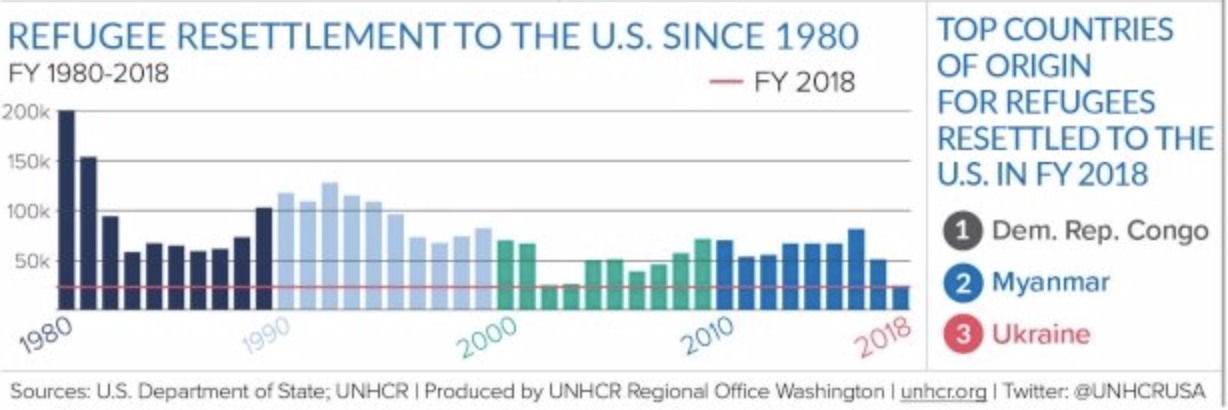World Relief’s Jennifer Foy talks about the transition from Trump to Biden
From Trump to Biden
The US Presidential race has now been called, and this means many policy changes given that ideological contrasts between Trump and Biden are deep and profound. This change in US administrations will touch most aspects of the humanitarian sector, from WHO membership, the Paris Agreements, and US support for humanitarian aid. 
One of my first thoughts when I began reading about the Biden administration goals regarding policies related to immigration and refugee flow into the United States was how these changes would impact the nine resettlement partner INGOs that work with the US State Department and UNHCR.
Since the passage of the Refugee Act in 1980 the United States has admitted more than 3 million refugees. The nine resettlement organizations are responsible for the hard work of processing, placement, and settlement of all refugees accepted into the US. These organizations include both seven faith based (FB) and two non-faith based INGOs (NFB), and each works with local NGOs, faith organizations, housing authorities, schools, and employers to help integrate refugees into their new communities.
Here are the resettlement organizations:
-
-
- Church World Service (CWS)
- Ethiopian Community Development Council (ECDC)
- Episcopal Migration Ministries (EMM)
- Hebrew Immigrant Aid Society (HIAS)
- International Rescue Committee (IRC)
- US Committee for Refugees and Immigrants (USCRI)
- Lutheran Immigration and Refugee Services (LIRS)
- United States Conference of Catholic Bishops (USCCB)
- World Relief Corporation (WR)
-
Under the eight year Obama administration the numbers of refugees processed were fairly high, nearly 70,000 per year. The Trump administration dramatically slowed the process nearly to a halt, setting a yearly goal of less than 15,000. The Biden plan is to immediately set a goal of 125,000 accepted per year and to raise the number steadily, meaning that the nine resettlement organizations would have to gear up their own staffing, training, and overall capacity. This also means that they will have to reinvigorate weakened community partnerships with all of the entities with which they coordinate in placing refugees in homes, schools, and places of employment. This rapid, radical ramping up poses massive challenges.
Jennifer Foy, Would Relief Vice President for US Programs
When I first met Jennifer Foy she was the director of the High Point, North Carolina World Relief office and was  tasked with organizing the placement of refugees in the area. [You can look here for my previous interviews with Jennifer.] Now she is based at the national in Baltimore office and is Executive Director for US operations for World Relief. In her current position she will be responsible for helping to ramp up her organization’s share of the waves of refugees needing to be placed during the Biden years.
tasked with organizing the placement of refugees in the area. [You can look here for my previous interviews with Jennifer.] Now she is based at the national in Baltimore office and is Executive Director for US operations for World Relief. In her current position she will be responsible for helping to ramp up her organization’s share of the waves of refugees needing to be placed during the Biden years.
As a point of reference, World Relief processed nearly 10,000 refugees in FY16, Obama era numbers. In FY20 under the Trump administration that number dropped to just over 2,000, a dramatic decrease. Using rough reckoning, under the Biden plan World Relief could be asked to handle as many as 15,000-20,000 refugees, as much as a 500% increase in cases handled. By any measure this is a massive task.
Jennifer was gracious in taking my call and agreeing to be interviewed about her thoughts on the tasks that her organization will be facing in the not too distance future.
Below are some questions I asked her a few days ago.
- What do the next six months look like to you in terms of re-invigorating your capacity to absorb a dramatically increased number of refugees?
- You work with many other organizations, including the IRC, in placing refugees around the United States. To what degree is there inter-agency coordination, cooperation, and communication?
- I can imagine that gearing up in terms of office space, etc. will be fairly easy. Human resources will be the biggest area of concern I am assuming, but also having to re-invigorated community partnerships as well. Can you comment on that?
- As you look at the Trump/Steven Miller years how would you characterize their philosophy on refugees? How would you describe the difference between their philosophy and what you imagined to be the Biden philosophy?
- On a personal level, how are you handling this extra pressure? I know that this must be very exciting, but at the same time daunting. How are you coping?
- Given that political polarization has seemed to get even more extreme in the last four years, do you think that refugees will face a difficult time, I should say or even a more difficult time, being excepted into the communities into which they are placed? How are the relief organizations preparing to respond to potential acts of xenophobia?
- As an officering in a faith based organization, can you comment on the intersection between the religiously drivers of your organization’s actions and the more general ‘humanitarian imperative’?
Here is Jennifer responding to my questions:


 Follow
Follow